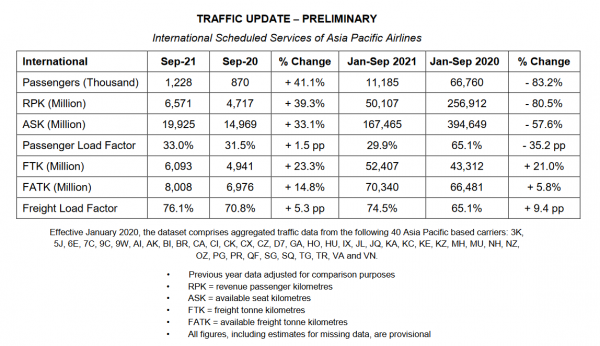KUALA LUMPUR, 27 October 2021: Preliminary September 2021 traffic figures released Tuesday by the Association of Asia Pacific Airlines (AAPA) revealed yet another month of severe weakness in international air passenger demand.
In contrast, international air cargo markets continued to strengthen on the back of growth in demand.

During September, the region’s airlines carried 1.2 million international passengers, representing 4.1% of the 30 million recorded in the same month of 2019. The international passenger load factor averaged 33%, whilst available seat capacity was 13.9% of pre-pandemic levels.
Amidst ongoing recovery in the global economy, strong consumer and business sentiment continued to boost trade activity, benefitting air cargo markets. Prolonged congestion at major shipping ports and associated global supply chain disruptions have also led to businesses turning to air cargo to speed up deliveries.
As a result, Asia Pacific airlines saw a 23.3% year-on-year growth in international air cargo demand as measured in freight tonne-kilometres (FTK) in September. Offered freight capacity recorded a relatively slower 14.8% year-on-year increase, driving the average international freight load factor to 76.1% for the month.
Commenting on the results, AAPA director-general Subhas Menon said: “The severe weakness in international passenger numbers seen since the onset of the pandemic reflects the border restrictions enforced by governments across the region.”
He added: “Nevertheless, as vaccination rates increase, more governments are moving away from zero-Covid-19 approaches towards a risk-managed approach in favour of relaxation of border restrictions for vaccinated travellers. This is a welcome step towards the recovery of air travel. The encouraging increase in ticket bookings in markets where barriers to travel have been lowered also reflect strong travel confidence.”
However, he concluded that for air passenger recovery to gain more substantial momentum, inconsistent health and border measures needed to be replaced with harmonised or mutually recognised protocols that would remove the complexity and confusion for the travelling public.
“We urge more governments to collaborate across borders in adopting an objective risk-based approach in line with WHO and ICAO guidelines to restore global air travel mobility.”







